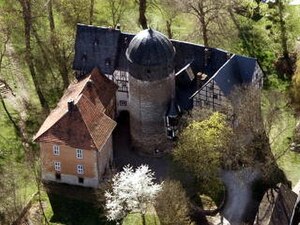Furra Castle
| Furra Castle | ||
|---|---|---|
|
Grossfurra Castle |
||
| Alternative name (s): | Großfurra, Wuor, Castle | |
| Creation time : | 1100 to 1200 | |
| Castle type : | Niederungsburg | |
| Conservation status: | essential parts preserved or restored | |
| Standing position : | Nobles | |
| Construction: | Truss | |
| Place: | Sondershausen - Großfurra | |
| Geographical location | 51 ° 23 '32.5 " N , 10 ° 47' 51" E | |
| Height: | 215 m above sea level NHN | |
|
|
||
The castle Furra even Großfurra , outdated Wuor or popularly known castle called, grew out of a moated castle in the middle of today's local part Großfurra the city Sondershausen in Kyffhäuserkreis in Thuringia .
history
The Fulda monastery was located in Furra as early as the 9th century. The moated castle was built in the 11th century by the Thuringian landgraves and was first mentioned in 1198 in the possession of the von Furra family. With this castle, the residents controlled the Wippertal west of Sondershausen. The Lords of Furra became followers of the Margraves of Meissen in 1249 and in 1276 they are mentioned as Honstein vassals.
After 1332, the family of Furra had died out, the castle was to various noble families invested and was divided into the eastern wing, the Bailiwick and the Western, the noble fief.
From 1425 the von Wurmb family gradually acquired the parts of the castle from the various noble families and controlled the history of the castle and its lands for over 500 years.
Between 1525 and 1526, the von Wurmb family was driven from the castle by rebellious farmers during the Peasants' War . After the rebellion was put down, it was returned to the family. The former protective castle became more and more a fortress against the farmers, it was rebuilt several times in the following years, survived the plague , numerous wars and remained almost unscathed until the end of the Second World War in 1945.
American artillery bombardment of Großfurra in April 1945 also hit the keep of the castle. Under the subsequent Soviet occupation from July 1945, the von Wurmb family was expropriated and expelled without compensation . The building, popularly known as the castle , was looted, then owned by the people and used as a school, kindergarten and further for refugee apartments. The valuable library was lost. The expropriation also affected the extensive manor buildings and the land. The 500 meter long castle wall was torn down and the stones were used for the foundations of new buildings. The Wurmbsche funeral chapel with a tomb and coffins became a Catholic church and so survived the turmoil of the times.
After the fall of the Wall in 1990, the building, which had now become ailing, was empty because the major renovation measures that were to be carried out were too expensive. The tower had a long crack, roofs, walls and windows were broken.
After the building was bought by the Bavarian businessman from Göttingen, Helmut Pohl, the buildings were extensively renovated and restored from 1996 to 2004 under the premises of monument law, and they are now his living and company domicile.
Building description
The original castle complex was a walled water castle with a two-wing, massive core structure, one two-story and one three-story with a half-timbered structure . The round, 20 meter high keep with a diameter of 10 meters and a domed roof is integrated into the building.
The former palace park is a pleasure garden laid out in the 17th century , which was transformed into a landscape garden in the middle of the 19th century. In 1945 and afterwards the park was partially closed and the stock of beautiful old trees was cleared by felling.
literature
- Michael Köhler: Thuringian castles and fortified prehistoric and early historical living spaces . 2nd expanded and revised edition. Jenzig-Verlag, Jena 2003, ISBN 3-910141-56-0 , pp. 114-115.
- Thomas Bienert: Medieval castles in Thuringia - 430 castles, castle ruins and fortifications . 1st edition. Wartberg Verlag, Gudensberg-Gleichen 2000, ISBN 3-86134-631-1 , pp. 150-151.
- Hans Maresch, Doris Maresch: Castles & Palaces (= Thuringia worth seeing ). VHT - VerlagsHaus Thüringen, Erfurt 1996, ISBN 3-89683-105-4 .
- Bruno J. Sobotka (Ed.): Castles, palaces, manor houses in Thuringia (= publications of the German Castle Association. Series C: Castles, palaces and manor houses. Vol. 4). Theiss, Stuttgart 1995, ISBN 3-8062-1123-X .

